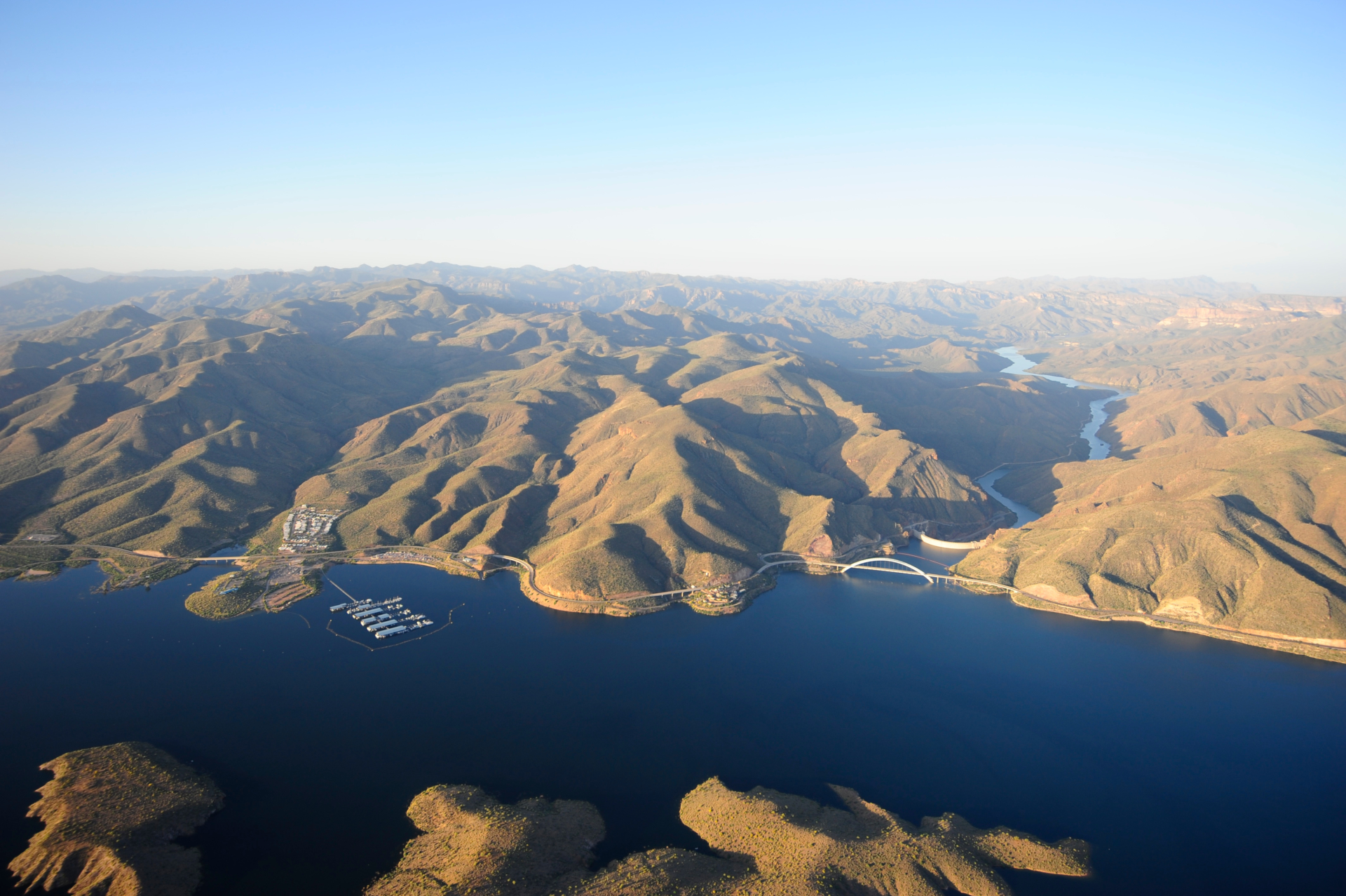Arizona is one of the fastest-growing states in the nation, gaining about 150,000 new residents annually. Along with the rise in population comes an increase in home, business and entertainment development that draws on local utilities and water supply. Despite this, the state uses less water than it did more than 60 years ago, when the population was one-seventh the size. According to the Arizona Department of Water Resources (ADWR), the state used about 7.1 million acre-feet of fresh water in 1957; in 2017, that figure had decreased to 7 million acre-feet. An acre-foot is almost 326,000 gallons, or enough to cover a football field in one foot of water.
“When it comes to water management, the policy has always been to have long-term planning,” says Dave Roberts, associate general manager of water resources for Salt River Project (SRP). “We stand on the shoulders of some visionary planners who saw the value of harnessing the Salt River and also making sure that we got our fair share of the Colorado River supply.”
READ ALSO: Phoenix is No. 1 for net inbound moves
More than half the Valley’s water comes from the Salt and Verde river watersheds, which are managed by SRP. Thirty-six percent of the state’s supply comes from the Colorado River. This month, the ADWR announced that Lake Mead, the biggest reservoir on the Colorado River, has declined to its lowest level since the reservoir was filled in the 1930s following the construction of Hoover Dam. Currently, the river is operating at a “Tier Zero” status, meaning the state is required to contribute 192,000 acre-feet of Arizona’s 2.8 million acre-foot annual entitlement. This contribution will come entirely from the 336-mile Central Arizona Project (CAP) canal system. Based on its 24-month study, it’s likely that the U.S. Bureau of Reclamation will elevate the shortage to “Tier 1” in 2022. This would require Arizona to reduce usage by 512,000 acre-feet, again, almost entirely from the CAP system.
As unrelenting drought and rising temperatures threaten the state’s watersheds, Valley water leaders are looking at ways to ensure a continued reserve of this natural resource to support development into the next century.
A healthy supply
“One of the things that is key for SRP is ensuring that the watersheds that produce our water are healthy,” Roberts says. SRP receives water from the Salt River, which is formed by the confluence of the White and Black rivers in the White Mountains to the east of Phoenix, and the Verde River, which flows from Yavapai County to the north.
“Because the Colorado River watershed gets most of its runoff in the late spring and summer, it’s more susceptible to warming temperatures,” Roberts explains. “Runoff in the Salt and Verde systems occurs much earlier, when the sun angles are lower. That makes us more resilient.”
While below-average snowpack this past winter, combined with drought conditions, has reduced runoff — SRP’s total reservoir system is at 75%, down slightly from 98% one year ago — the company’s main concern is the health of forests along the watersheds and the risk of catastrophic wildfires. “We’ve had lot of fires over the past 30 years, and they’ve gotten increasingly larger. They affect the water quality because our supply runs through those lands,” Roberts says. “Water comes through the burned and scarred areas and picks up all kinds of debris and contaminants, making it difficult to treat and deliver.” Preventative thinning of dense brush and small overcrowded trees reduces the fuel that leads to larger, more devastating fires.
On the Verde River side of the system, the uppermost reservoir, Horseshoe Dam, which is shared by SRP and the City of Phoenix, also has its share of difficulties. “The reservoir has been filling in with sediment over the years,” Roberts notes. As of April 2021, the Verde system is operating at just 32%, with Horseshoe Lake at 5% full and Bartlett Lake at 49%. “SRP is working with the Bureau of Reclamation to assess what options we have to mitigate that impact of sediment because we’ve lost more than a third of the capacity,” he adds. “We hope to make a plan to modify Bartlett Dam, expanding its capacity and creating additional supplies for others here in the Valley, outside of SRP. And then we would turn Horseshoe Dam into a facility that would capture sediment and use it to restore the riparian habitat for endangered species in the area.”
West Valley expansion
One of the fastest-growing regions in Greater Phoenix is the West Valley along State Route 303. Epcor, a privately owned utility company, provides water and wastewater services to thousands of homes and businesses from northern Peoria along the Agua Fria River to Buckeye, as well as areas around Paradise Valley, Fountain Hills, Rio Verde and Queen Creek.
In 2019, Epcor completed a
$33 million expansion of its White Tanks Regional Water Treatment Plant in Surprise, which increased the facility’s output from 20 million gallons per day (MGD) to 33 MGD. The site treats surface water delivered by the CAP canal system. “Surface water is considered a renewable resource, and we have allocations from CAP and the Maricopa Water District, and any of the water that is used by our customers comes back to our wastewater collection and treatment systems. It’s a long cycle of sustainability,” says Joe Gysel, president of Epcor USA.
Last year, the company finished construction on Phase 1 of the Luke 303 Regional Water Reclamation Facility in Litchfield Park, which can recharge and reuse up to 8 million gallons of treated effluent daily. Phase 2 of the $95 million project is scheduled for completion in the first quarter of 2022. “It will connect to a new trunk line that we put in last year that runs from north Glendale down to our plant, which is in the shadow of Luke Air Force Base
“That side of the Valley is a very large growth area for us,” Gysel adds. “And all of the wastewater that we collect is recharged 100%. We have large recharge basins, and we treat it to A+ quality standards, and then it all goes back into the aquifer.”
A recent concern in the West Valley is the presence of polyfluoroalkyl substances (PFAS) in the water supply coming from Luke Air Force Base. These chemicals, which were designed to repel oil, water and grease, are found in a firefighting foam that the military began using in the 1970s. A study released by the Air Force in February showed that high levels of PFAS had affected drinking water for about 1,600 homes and businesses, none of which are serviced by Epcor. “PFAS are emerging contaminants that have a lot of people very concerned,” Gysel says. “They pollute the groundwater, and they’re forever chemicals, which means they never dissipate. The main issue is that there’s no minimum contaminant level adjudicated by the Environmental Protection Agency.”
An integrated approach
High-growth areas, such as San Tan Valley, Buckeye and Pinal County, face the biggest struggles because of low supplies of surface water, which is renewable, and limited groundwater, which is finite.
In most water systems, drinking, waste and recycled water are managed separately. Global Water Resources, a private, investor-owned utility that services communities around Metro Phoenix, offers its Total Waste Management approach, which manages the entire water cycle within the same geographical area. “We look at it from a more holistic standpoint, where it’s best if the water provider is also the wastewater and recycled water provider,” explains Ron Fleming, president and CEO of Global Water Resources. “Instead of building giant wastewater treatment plants outside of town, where you’re limited with what you can do with the effluent once you’ve treated it, we build smaller scale reclamation facilities inside the communities that take the wastewater and convert it into a usable, renewable resource.”
Wastewater is recycled and delivered back for use as nonpotable irrigation for common areas, landscaping and golf courses. Biosolids, the organic masses that are separated from the wastewater, are treated and used for nonconsumption agricultural purposes. If the Bureau of Reclamation initiates Tier 1 shortages, agriculture will be the hardest-hit sector. “What people don’t often realize is that residential and commercial buildings don’t use half the amount of water that agriculture does,” Gysel explains.
The individual customer also plays a role in conservation. Global Water offers an innovative seven-tier rate structure. The less water you use, the less you pay. And if usage is 90% less than the community average, the customer receives a rebate by way of a reduction on their bill. “We’re sending the right price signals for a precious resource and, beyond that, we’re giving people the information they need to be able to act,” Fleming explains. “If they play it right, if they maximize recycled water and recharge any excess to the supply, then they are making meaningful changes.”
For many years, reclaimed water was not regarded as a resource, but in the last 25 to 30 years, policy has been to make use of every drop. Notes Roberts, “Water that has a second or third or fourth life is going to be the key for long-term stability.”




